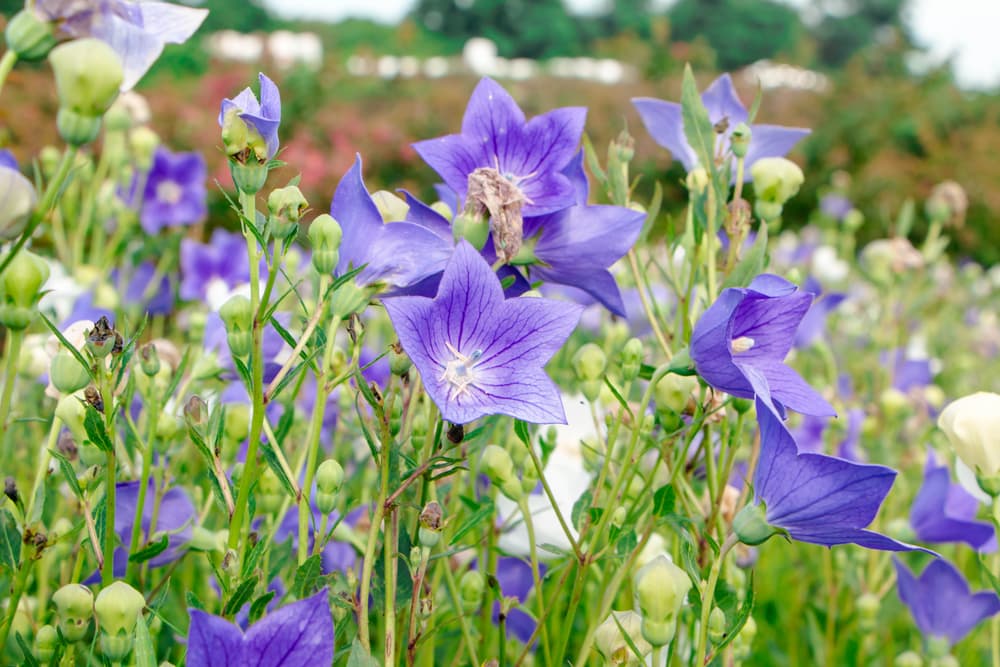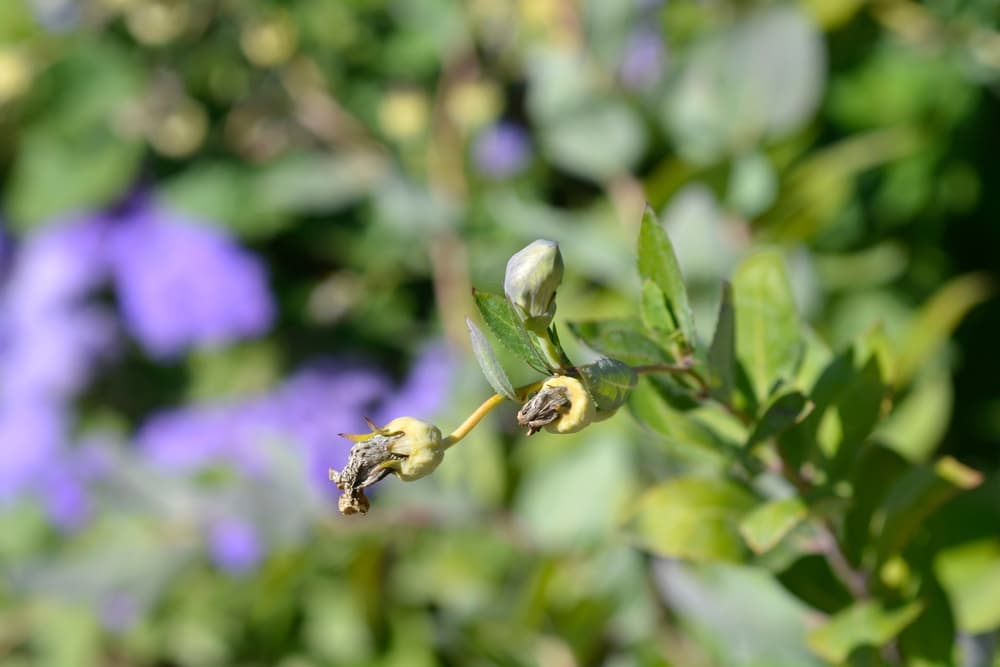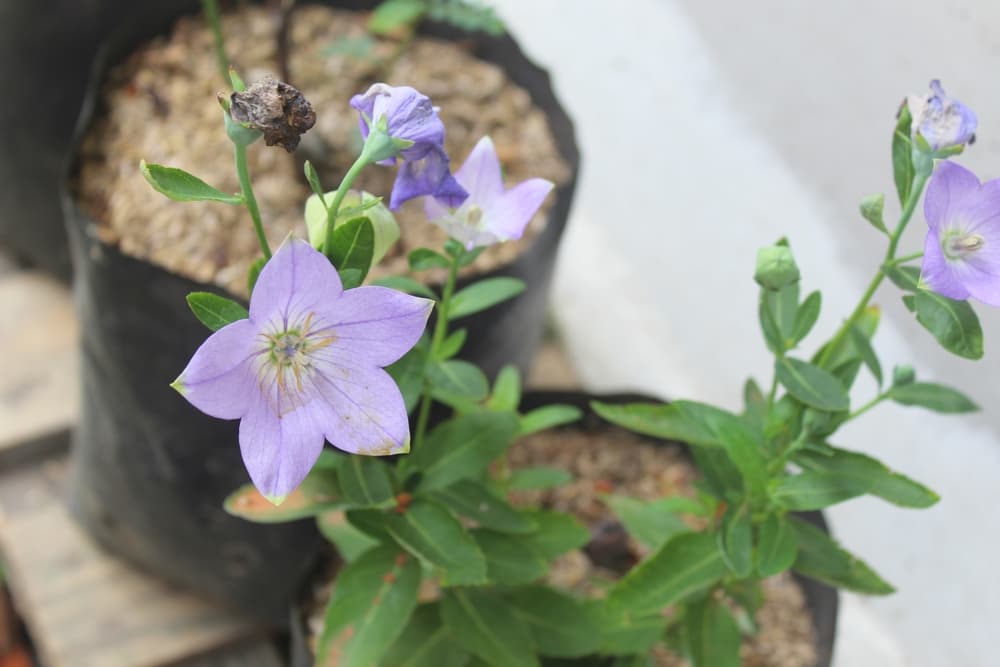PERENNIALS > PLATYCODON
Reviewed By COLIN SKELLY

Colin is a Horticulturist and Horticultural Consultant with experience in a range of practical and managerial roles across heritage, commercial and public horticulture. He holds the Royal Horticultural Society’s Master of Horticulture award and has a particular interest in horticultural ecology and naturalistic planting for habitat and climate resilience.
IN THIS GUIDE
PLATYCODON GUIDES
This plant’s buds are amusing, to say the least, as they perfectly resemble puffed-up mini balloons.
But the open flower is so very different with its elegant trumpet shape and the face-on five-point star display in rich, deep purple tones.
And so, as bud or as flower, it will charm your visitors and trigger a conversation.
Just before the bud blossoms into a flower it looks for all the world like a puffed-up balloon just crying out to be popped (not that we recommend it).
Indeed, not infrequently a Balloon Flower bud will resemble a hot-air balloon in miniature.

Opened up, this merry flower is elegantly trumpet-shaped and viewed face-on is essentially a five-point star.
Adjacent petals are joined at about the halfway point.
Overview
| Botanical Name | Platycodon |
| Common Name(s) | Balloon Flower |
| Plant Type | Perennial Flower |
| Native Area | Far East |
| Hardiness Rating | H5 |
| Foliage | Deciduous |
| Flowers | Open, bell-shaped flowers |
| When To Sow | April, May, June |
| Flowering Months | July, August, September |
| When To Prune | October |
Sunlight
Preferred
Full Sun or Partial Shade
Exposure
Exposed or Sheltered
Size
Height
0.1 – 0.5M
Spread
0.1 – 0.5M
Bloom Time
July – September
Soil
Preferred
Loam
Moisture
Moist but well drained
pH
Any
The Balloon Flower, a member of the Platycodon genus, is a long-lived deciduous perennial that is native to East Asia.1Platycodon. (n.d.). Pacific Bulb Society. Retrieved March 22, 2023, from https://www.pacificbulbsociety.org/pbswiki/index.php/Platycodon
Platycodon is one of those rare genera that have a species count of one.
The sole species member of Genus Platycodon is P. grandiflorus and there are several cultivars of the species.

The genus is a member of the Campanula family which includes the Campanula or Bell Flower.
The mother species produces flowers of a rich purple hue with a delicate filigree of veins on the petals.
Though the Balloon Flower has made some serious inroads in gardens in the northern and eastern United States, it is far from common in the UK.
“Playcodon grandiflorus makes a great perennial plant in the UK,” shares Master Horticulturist Colin Skelly.
“It combines well with classic cottage garden plants although it can be used for multiple styles of planting, as well as being versatile in terms of soil pH (as long it is free-draining).”
This reliable perennial will not only bring brilliant splashes of colour to your garden in that transition period from the dog days of summer into autumn, it will make for an interesting topic of conversation because of its relative ‘newness’ and also for the enormous and varied cultural significance Platycodon has in Japan and the Koreas.
Habitat & Growing Conditions
The Chinese Bellflower grows freely in the fields, meadows, and steppes of north-eastern Russia, eastern China, Japan, and the Koreas.2Platycodon. (n.d.-b). Kew Royal Botanic Gardens. Retrieved March 22, 2023, from https://powo.science.kew.org/taxon/urn:lsid:ipni.org:names:5791-1
In Japan and the Koreas these plants are a common sight in cottage gardens and farmyards.
They tend to grow in sunny locations or part-shade locations.

They are not found in heavy or wet soils but they grow in soil pH ranging from Moderately Acidic to Slightly Alkaline.
Native to a relatively small swath of land, this robust plant adapts to all temperate and sub-tropical regions.
A large majority of varieties are hardy to Zone H5.
How To Grow Platycodon
You may have to visit a few nurseries and garden centres to find one that sells potted plants.
Platycodon seeds are available fairly widely, though not in a rich selection.
Where the Balloon Flower is concerned, in the UK you will have to make do with limited varieties.
However, if you have one Platycodon, you can get more.

First, these plants are fairly reliable self-seeders though not aggressively so.
You could also let the flowers dry out on the plant and then collect and store seeds though be mindful that cultivars usually will not grow true.
Growing From Seed
Though you can start Chinese Bellflowers indoors in small pots about six weeks before the last projected frost, in most regions of the UK it is a better idea to grow them outdoors from the off.
Anytime in spring, after there is no chance of a frost, drop seeds on the soil but do not cover them because they need light to germinate.
If you are concerned about birds picking up the seed then cover the seeds with a bare sprinkling of soil or protect them with garden mesh; water the seeds well.

As the seeds sprout and grow, water them moderately such that the soil usually stays moist but is not overly wet.
Balloon Flower’s water requirements are moderate.
Propagating From Cuttings
These plants can be grown quite reliably from stem cuttings.
- In late spring or early summer cut off about 10cm of the stem.
- Trim the leaves from the bottom half of the cutting.
- Dip the base of the stem in water, and apply some rooting hormone or dip it in honey and then in cinnamon.
- Plant the cutting in damp soil of the type described above, amended with potting soil near the surface.
- Water moderately so as to keep the soil moist.
Where To Grow
As mentioned, Platycodon is tailor-made for borders, edges, and mixed shrubberies.
However, its proclivity of growing in thick clumps makes it a great choice for attractive groundcover.
This deciduous plant tends to rise in mid-to-late spring; on the other hand, in the autumn it provides colour through both its flowers and its foliage.

It is this latter feature that makes dwarf varieties such as ‘Baby Blue’ and ‘Zwerg’ ideal for rockeries.
’Shell Pink,’ a mid-height variety with pink flowers is a top choice for a front border; the tall ‘Hakone’ cultivars in blue and white are equally fine choices for a rear border.
However, each of these varieties may need staking, otherwise pinch the growing tip or cut it early on so that it is less lanky and more bushy.
Many Balloon Flower varieties are excellent choices for potted plants and mixed containers for the patio and the porch.

Plant Care
In the UK these plants should be grown in full sun but part shade will do perfectly well.
Soil Requirements
Platycodon should be grown in a rich loam with little to no clay but with some organic humus or compost.
Soil should drain very well – they grow best in soil with pH between 5.6 and 7.3.
Overwintering
Flowers should be deadheaded.
After the plant has died down, cut off the withered foliage but do not cut the stem down to the ground.
Before winter sets in, apply a good layer of organic mulch.
Reduce the frequency and amount of water.
Then, in spring, remove the mulch after there is no chance of frost.
This plant tends to rise later in spring than other deciduous perennials.

Take care not to disturb Platycodon’s fleshy roots in any way as they are quite delicate.
An application of a balanced slow-release fertiliser once in late spring would be beneficial.
You will invariably see the taller cultivars getting floppy, especially in late summer to early autumn.
It’s not that the plant has gone leggy; it is simply a trait of the taller varieties.
You can pinch the leader or growing tip to encourage bushy growth early on, otherwise stake the plant.

Pruning
Only the taller cultivars need pruning, especially those whose heights are significantly greater than their spreads, such as ‘Blaue Glocke’ and ‘Fuji Blue’.
Either keep pruning such varieties judiciously to attain a compact form or pinch the leader or growing tip.
Common Problems
Platycodon are remarkably pest-resistant and disease-free.
Snails and slugs like this plant so be vigilant for these pesky critters which are less of a danger and more of a nuisance.
References
- 1Platycodon. (n.d.). Pacific Bulb Society. Retrieved March 22, 2023, from https://www.pacificbulbsociety.org/pbswiki/index.php/Platycodon
- 2Platycodon. (n.d.-b). Kew Royal Botanic Gardens. Retrieved March 22, 2023, from https://powo.science.kew.org/taxon/urn:lsid:ipni.org:names:5791-1


